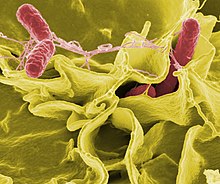Cellular microbiology
The Cellular Microbiology is a branch of biology . It connects and bridges the areas of cell biology and microbiology .
The term "cellular microbiology" was created in a 1996 Science article. Cooperation and interdependence between cell biology and microbiology had increased in previous years, and the emergence of a new branch had been proposed and discussed in several biology conferences.
Cellular microbiology tries to apply pathogenic microorganisms as research tools for cell biology, while using cell biological methods to understand the pathogenicity of microorganisms. Toxins and virulence factors from microorganisms have been used for decades to influence and research processes in eukaryotic cells . It has been increasingly found that simply applying purified toxins to cells cannot always provide the big picture and that understanding the role of toxins in pathogenicity, the way in which toxins promote the microorganism, the manufacturing processes of the toxins and their coevolution with host cell factors is crucial.
Numerous eukaryotic cell processes were elucidated using microbial "tools". One of the main topics is the cytoskeleton . Many microorganisms influence the synthesis and breakdown of the host cell's cytoskeleton, especially the actin network. Intracellular microorganisms such as B. the bacteria Shigella and Salmonella , trigger actin polymerisation in host cells that normally do not accept bacteria (i.e. non- phagocytes ). This causes deposits to form which ultimately envelop the bacteria. Yersinia bacteria, on the other hand, inhibit actin polymerisation in phagocytes and thereby avoid phagocytosis . Cellular microbiology seeks to understand these processes and the ways in which they promote infection .
Other eukaryotic processes that affect microorganisms and that are researched using microorganisms are e.g. B. signal transduction , metabolism , vesicle transport , cell cycle and transcriptional regulation , to name a few.
Individual evidence
- ↑ P. Cossart, P. Boquet, S. Normark , R. Rappuoli: Cellular microbiology emerging . In: Science . 271, 1996, pp. 315-317.
- ↑ S. Dramsi, P. Cossart: Intracellular pathogens and the actin cytoskeleton . In: Annu Rev Cell Dev Biol . 14, 1998, pp. 137-166. doi : 10.1146 / annurev.cellbio.14.1.137 .
